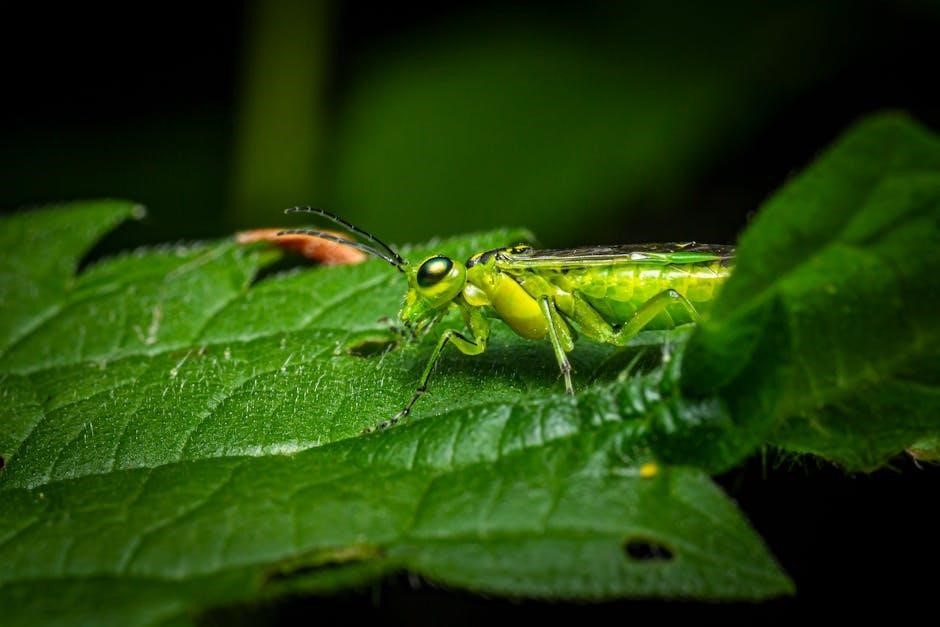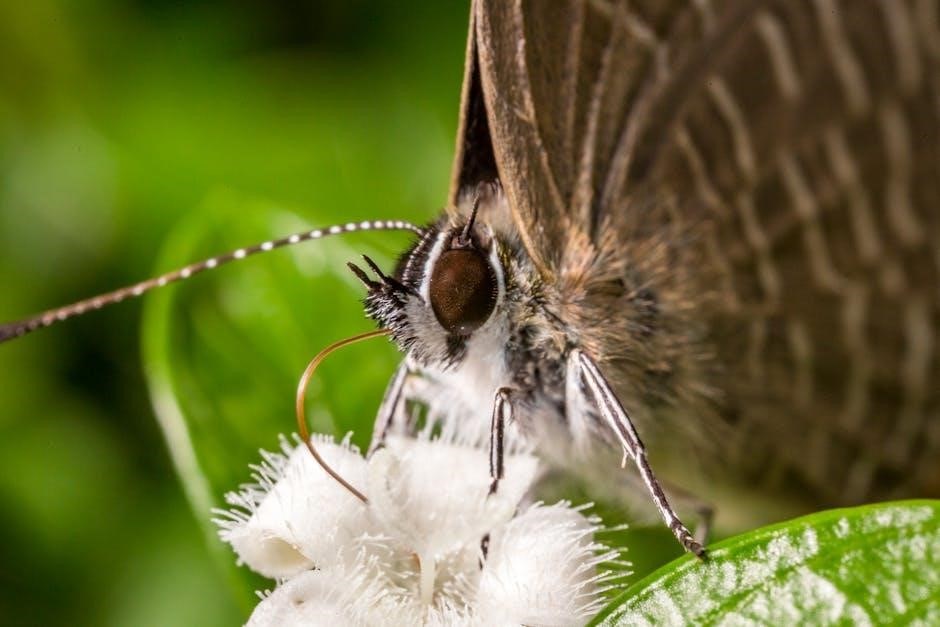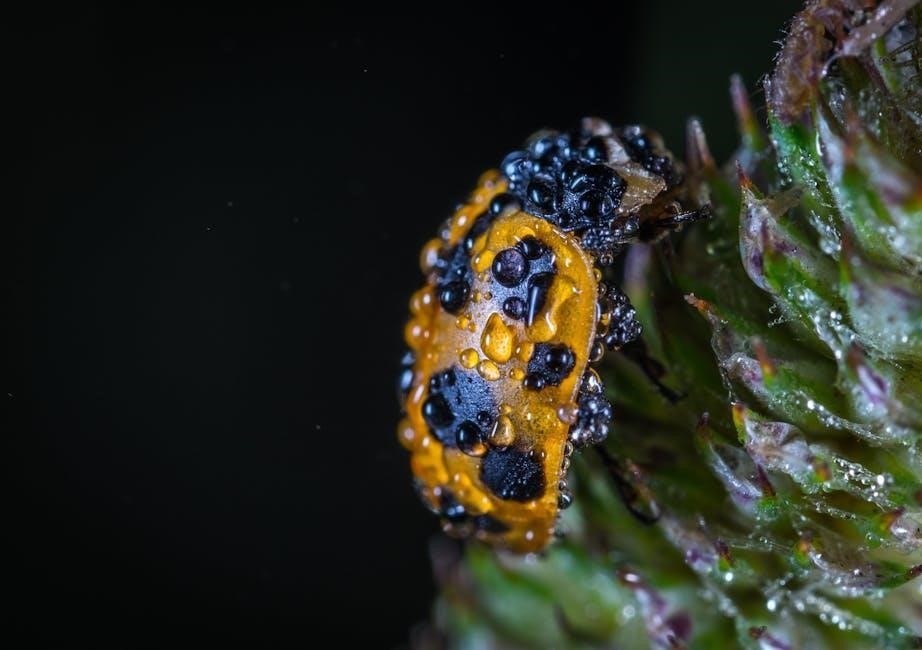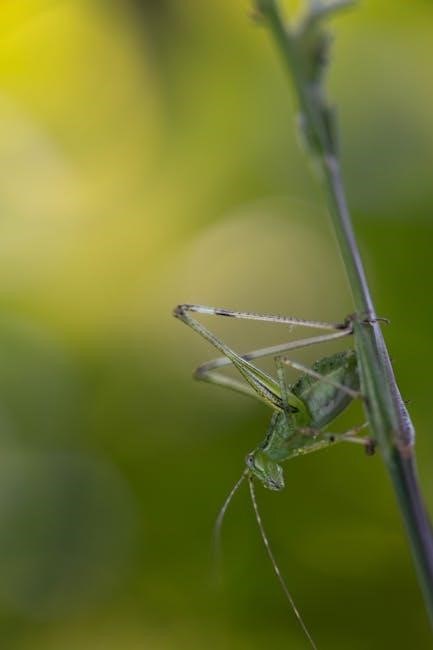Welcome to the Animal Crossing: New Leaf Bugs Guide! This guide is designed to help you navigate the fascinating world of bug catching in the game. Discover the various species, tips for catching, and strategies to build your collection effectively.
Types of Bugs in Animal Crossing: New Leaf
Animal Crossing: New Leaf features a wide variety of bugs, including common species like grasshoppers and beetles, rare ones such as the Giant Cicada, and new additions like the Rice Grasshopper. Each type offers unique challenges and rewards for collectors.
Common Bugs Found Throughout the Year
In Animal Crossing: New Leaf, common bugs like grasshoppers, ladybugs, and fireflies can be found throughout most of the year. These bugs are relatively easy to catch and appear in various locations, including grass, flowers, and near water. Grasshoppers are particularly active during the day in warm weather, while ladybugs often appear near flowers. Fireflies, on the other hand, are nocturnal and can be spotted near rivers or ponds at night.
Other common bugs include crickets, ants, and beetles, which are frequently found on trees or on the ground. These bugs are great for beginners to practice their catching skills. Some, like the cricket, are active year-round, making them a reliable option for players. With patience and practice, you can build a diverse collection of these common yet fascinating insects.
- Grasshoppers: Active during the day, especially in warm months.
- Ladybugs: Often found near flowers.
- Fireflies: Nocturnal and appear near water sources.
These bugs are perfect for starting your collection and learning the basics of bug catching in the game.
Rare and Hard-to-Find Bugs
In Animal Crossing: New Leaf, certain bugs are elusive and challenging to find, making them highly sought after by collectors. These rare bugs often appear under specific conditions or during limited time frames, adding to their exclusivity. For instance, the Giant Cicada and Hermit Crab are rare and can only be found during certain months or in particular locations.
The Wharf Roach is another rare bug that appears near water at night, requiring precise timing and patience to catch. Additionally, bugs like the Stinkbug and Tiger Beetle are uncommon and may only appear in specific weather conditions or on certain terrain. These rare bugs are a true test of a player’s dedication and skill.
- Giant Cicada: Limited to specific months and locations.
- Hermit Crab: Found near beaches during certain times.
- Wharf Roach: Appears near water at night.
Tracking these rare bugs can be rewarding, but it demands persistence and a deep understanding of their habitats and behaviors.
New Bugs Introduced in Animal Crossing: New Leaf
Animal Crossing: New Leaf introduced several new bugs that were not present in previous games, adding fresh challenges and opportunities for players. These new additions include the Rice Grasshopper, Giant Cicada, Cicada Shell, Stinkbug, Tiger Beetle, Hermit Crab, Wharf Roach, and House Centipede. Each of these bugs has unique characteristics and habitats, making them exciting to discover.
The Giant Cicada and Cicada Shell are particularly notable, as they can be found on trees during specific seasons. The Hermit Crab and Wharf Roach are rare and appear in coastal areas or near water. These new bugs diversify the gameplay and provide players with more goals to achieve in their collections.
- Rice Grasshopper: Found in grassy areas during the day.
- Giant Cicada: Appears on trees during summer months.
- Hermit Crab: Spotted near beaches at night.
These new bugs enhance the game’s realism and offer players a broader range of insects to hunt and study.

Catching Bugs: Tips and Techniques
Mastering bug-catching in Animal Crossing: New Leaf requires patience and the right approach. Use the net effectively, approach slowly, and aim carefully. Equip the right tools and learn bug habitats for success.
- Move quietly to avoid scaring bugs away.
- Use the net’s full range for distant catches.
- Timing is key for fast-moving insects.
Practice makes perfect in building your bug collection!
Best Times of Day to Catch Bugs
In Animal Crossing: New Leaf, bugs are active at specific times, making timing crucial for catching them. Most bugs are diurnal, appearing during daylight hours, while others are nocturnal, emerging at night. For instance, the Common Butterfly and Ladybug are often seen during the day, while the Firefly and Cicada are more active after sunset. Some bugs, like the Moth, are drawn to light sources at night, making them easier to spot near illuminated areas. Understanding these patterns helps maximize your bug-catching efficiency. Additionally, certain events like the Bug-Off, held on the third Saturday of each month from June to September, provide unique opportunities to catch rare species between 9 AM and 6 PM. By adjusting your schedule to match bug activity times, you can build a diverse and impressive collection. Always keep an eye on the clock to ensure you don’t miss out on elusive species!
Effective Bug-Catching Techniques

Mastering bug-catching in Animal Crossing: New Leaf requires a combination of skill, patience, and strategy. One of the most effective techniques is to approach bugs slowly and carefully to avoid startling them. Use the net by holding the A button and releasing it just as you reach the bug for a precise catch. For flying bugs, time your swing when they land or hover close to the ground. Additionally, certain bugs, like the Hermit Crab, can be lured by approaching them from behind. Weather conditions also play a role; for example, rain can make some bugs more active. The Bug-Off event, held on the third Saturday of each month from June to September, is a great opportunity to catch rare species. Using the Golden Net, unlocked later in the game, increases your catching range and efficiency. By combining these techniques with knowledge of bug habitats and schedules, you can build a thriving bug collection and impress the game’s characters. Happy bug hunting!
Impact of Weather Conditions on Bug Availability
Weather conditions significantly influence bug availability and behavior in Animal Crossing: New Leaf. Rainy days, for instance, make certain bugs like beetles and snails more active, while others may retreat. Heatwaves can increase the presence of grasshoppers and cicadas, as they thrive in warmer temperatures. Conversely, colder weather reduces bug activity, with many species hibernating or becoming scarce. Seasonal changes also play a role, as some bugs only appear during specific times of the year. For example, winter months see fewer bug species, while summer brings a variety of active insects. Additionally, weather-related events, such as heavy rain or storms, can temporarily alter bug behavior. Understanding these weather patterns is crucial for efficiently catching bugs, as it allows players to anticipate which species will be active. By adjusting your bug-catching efforts according to the weather, you can maximize your chances of completing your collection. This dynamic aspect adds depth to the game, making every day unique for bug enthusiasts.

Seasonal Bug Availability
In Animal Crossing: New Leaf, bug availability changes with the seasons. Winter offers fewer species, while summer brings a variety of insects. The guide details monthly schedules, helping players track when and where to find each bug.
Monthly Bug Schedule and Availability
The availability of bugs in Animal Crossing: New Leaf varies significantly throughout the year, with specific species appearing during certain months. This guide provides a detailed breakdown of which bugs can be caught each month, ensuring players never miss an opportunity to complete their collection. For example, the Diving Beetle and Frog are commonly found in May, while the Giant Cicada and Rice Grasshopper emerge during the summer months. Some bugs, like the Hermit Crab, are available year-round but only in specific locations. Weather conditions and time of day also influence availability, adding another layer of strategy to bug hunting. By tracking the monthly schedule, players can plan their bug-catching adventures effectively and ensure they catch every species as they become available. This section is essential for understanding the dynamic nature of the game’s bug world and maximizing your collection.
Understanding the Bug-Off Event

The Bug-Off is a monthly event in Animal Crossing: New Leaf that takes place on the 3rd Saturday of each month from June to September. During this event, players can participate in a friendly bug-catching competition hosted by Nate the Chameleon. To join, simply bring Nate a bug between 9 AM and 6 PM, and he will award points based on the rarity and size of the bug. The goal is to earn the highest score possible, with prizes awarded to the top participants. These prizes often include exclusive furniture or special items that cannot be obtained elsewhere in the game. The Bug-Off is a great way to test your bug-catching skills, learn about rare species, and compete with friends. Points are determined by factors like the bug’s rarity and its size, so aim to catch the largest and most elusive species. This event adds a fun competitive twist to the game, making it a highlight for many players.
Maximizing Your Bug Collection
To maximize your bug collection in Animal Crossing: New Leaf, it’s essential to explore various strategies and utilize in-game features. One key tip is to regularly visit Tortimer Island, where bugs are available year-round due to its perpetual summer climate. Additionally, participate in the Bug-Off event held on the 3rd Saturday of each month from June to September, where you can earn exclusive rewards and rare bugs. Keeping your net upgraded will also improve your chances of catching elusive species. Another effective strategy is to maintain a high town rating, as this attracts rare bugs to your environment. Seasonal availability plays a significant role, so refer to monthly bug schedules to track species. Lastly, visiting friends’ towns can provide opportunities to catch bugs not available in your own town. By combining these methods, you can efficiently build a diverse and complete bug collection, showcasing your dedication as a bug enthusiast in Animal Crossing: New Leaf.
